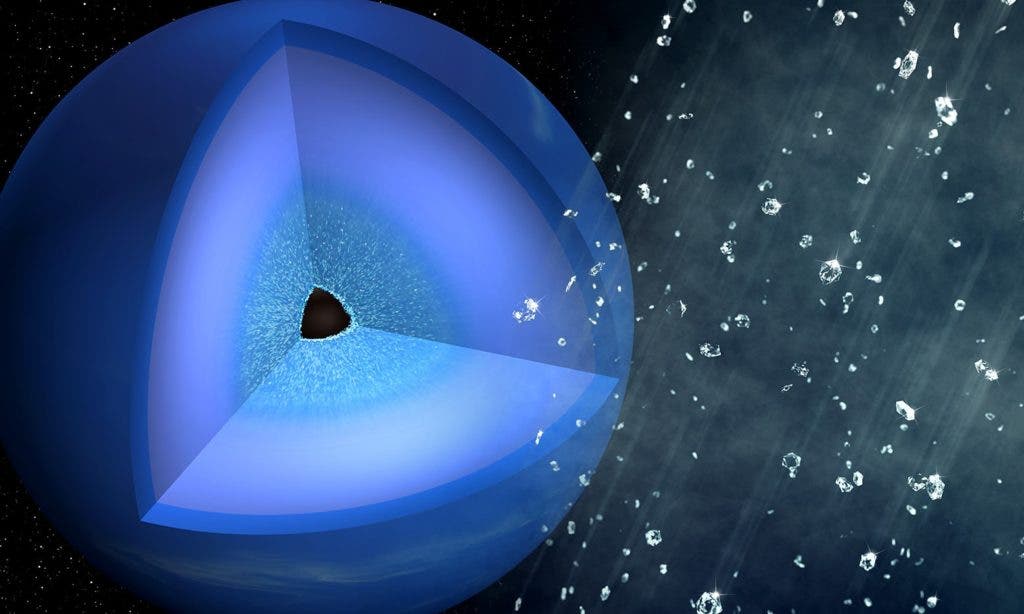Scientists fired lasers onto the humble polystyrene to recreate a luxurious sight thought to be common on the farthest-flung planets of the solar system: diamond rain.

The two blue marbles of Neptune and Uranus are the least visited planets in our Solar System. Up until now, the only vehicle that has ever visited Uranus and Neptune was NASA’s Voyager 2, which launched in 1977. This flyby, however, raised more questions than it answered. For instance, these two outermost planets of the solar system are some times referred to as the ‘ice giants’ but the reality is we don’t know that much about what they’re made of. We know both have a solid core, that temperatures and pressure can be very high or that both have a dense atmosphere. We don’t know very specifically what’s inside behind their blue blankets since all the data we have comes from a single flyby mission and Earth-based telescope.
This massive gap in knowledge might hopefully be bridged if a NASA mission to send three orbiters to Uranus and Neptune by 2030s gets the resources it needs. Until then, scientists have to do with what they got.
British researchers, for instance, have mimicked the atmospheric conditions on both planets to test whether a long-standing and curious assumption has any footing. For many years scientists have posited that it rains diamonds on both planets, a hypothesis that has long proved very tricky to confirm in the lab. But now, an international team of scientists led by Dominik Kraus from German research lab Helmholtz-Zentrum Dresden-Rossendorf has finally done it.
A diamond furnace
To achieve their goal, the team fired a high-power laser at polystyrene, a common household material here on Earth but also a complex molecule that mimics the hydrocarbon soup seen in the atmosphere of the ice giants. Inside a treated environment, when the first laser pulse hit the foam, an initial shock wave was ejected. A second shock wave, this time faster, was made by a second pulse. When the two waves met, some very extreme conditions were created: temperatures and pressures of about 5,000 Kelvin and 150 GPa or roughly about as hot as the sun’s surface and one a half million times more pressure than at Earth’s sea level, respectively.
All of this was hot enough to break the bonds between the carbon and hydrogen inside the polystyrene. The pressure was also high enough to cause the carbon to bind together and form diamonds, which the scientists observed in minute molecular detail using very short pulses of X-rays.
Inside the lab, it rained with nanoparticles of diamonds but inside Neptune’s atmosphere, these might be far bigger, the team reported in Nature Astronomy.
Once these diamond drops fall on the planet’s surface, they’ll sink down to the very bottom. This is another reason why this paper is neat. You see, for some time physicists have been debating the structure of both planets. It’s thought that the atmosphere — the outermost layer – is made of hydrogen, helium, and methane, which sits atop a liquid hydrogen layer including helium and methane. The lowest layer is liquid hydrogen compounds, oxygen, and nitrogen, while the core is thought to be made of ice and rock. Now, these little diamonds will help other scientists better test and piece together what these planets’ structure looks like.
“These diamonds will sink down because they are heavier than the surrounding medium and when they sink down there will be friction with the surrounding medium, and at some point they will be stopped when they reach the core – and all this generates heat,” Kraus told The Guardian.
There might also be a practical dimension to the team’s findings. Kraus says that the market is in demand for artificial diamonds and some applications require finely sized ones — sounds like a perfect fit to me, though it remains to be seen whether it will also be economically feasible.
In any event, it’s amazing to not only hear about how it might rain freaking diamonds on an alien planet but also get a chance to experiment and prove it could happen.






